Winter Prep for Some of my Figs
Fig Abuse?
Anyone watching what I was doing to my fig trees might have called “Fig Protective Services” to have my trees removed to a new home. But figs are tough plants and tolerate a lot of what looks like abuse.
Let me offer some background: Figs are subtropical plants so can’t survive to fruit outdoors around here. I grow a few fig trees in pots that I can put in a protected location for winter (more on that later). Problem is that the trees’ roots eventually fill the pots and exhaust nutrients in the mix.
I could move each tree to a larger pot. Then the branches could grow commensurately larger, and more growth of branches translates to more figs to harvest. But these pots have to be moved every spring and fall, and there’s a limit to how big a pot I can handle.
The other way to give the roots new ground to explore is to root prune them. That is, slice off some roots to make space for new soil in the same pot. Trust me; I’ve done this for many years and the plants tolerate it well, growing happily each spring following the operation. (Fall or spring, when the plants are leafless, is the best time for root pruning and re-potting.)
So I tipped each plant on its side and pulled on the stem while holding the pot in place to slide the root ball out of the pot. 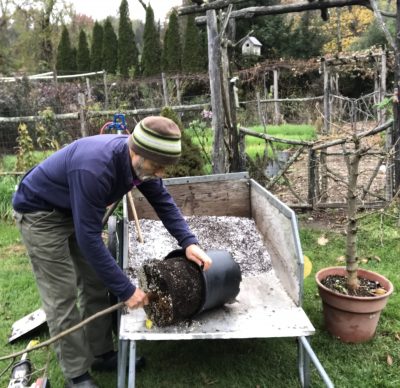 After standing the root ball upright, I started slicing it from top to bottom. For root balls 18 to 24 inches across, I slice a couple inches off all around. I used to use an old kitchen knife but discovered that my reciprocating saw with a medium-tooth blade works much better.
After standing the root ball upright, I started slicing it from top to bottom. For root balls 18 to 24 inches across, I slice a couple inches off all around. I used to use an old kitchen knife but discovered that my reciprocating saw with a medium-tooth blade works much better.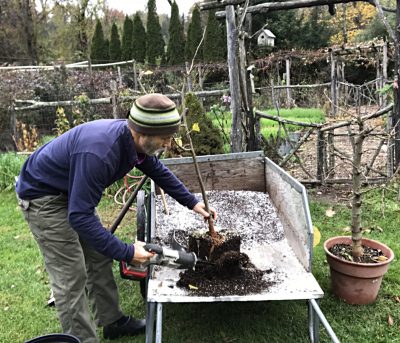
With the old root ball shrunken, it goes back into its pot and I start packing potting soil back in the space between the pared down root ball and the sides of the pot. 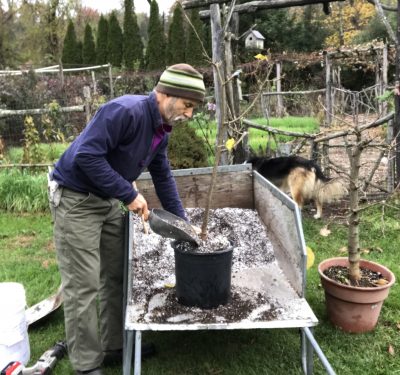 For good contact, I pack the potting soil in with my fingers and the flat end of a 3/4 inch dowel.
For good contact, I pack the potting soil in with my fingers and the flat end of a 3/4 inch dowel.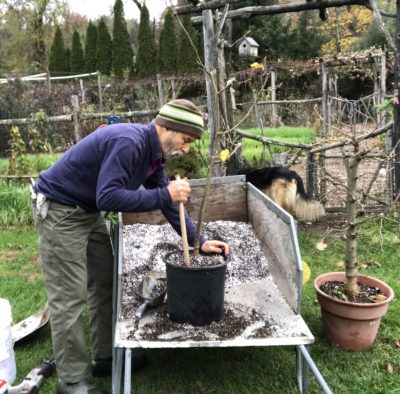
Next year at this time or, at most, two years from now, trees will get root-pruned again.
Winter Quarters
Now, what will I do with the fig trees for winter. It’s a conundrum, because the trees, being subtropical, do well with a cold season rest, ideally below 50°. On the other hand, they can’t tolerate cold much below about 25°F. in their pots.
Some places that might provide temperatures within this range are an unheated garage that’s attached to a house, an unheated and uninsulated basement, or an unheated foyer or mudroom. As long as they are dormant, the plants do not need light.
For many years, I’ve lugged my plants down the rather narrow stairway to my basement. There’s an oil burner down there but it’s rarely used since most of our heat is with wood. In midwinter, basement temperatures hover around 40°F.
As of this year, my days of lugging the heavy pots down stairs are over. I now have access to a ground level, unheated room in a well-insulated, rarely heated building having a concrete floor for good thermal mass. The Ritz!
The goal is to keep the plants cold enough so that they stay dormant until it’s safe to move them outdoors in spring. If all goes well, the plants are still dormant when outdoor temperatures rarely dip below 32°F. Then the plants, moved outdoors, slowly awaken with cool temperatures and bright sun promoting sturdy growth.
Because fig trees in pots tolerate temperatures down into the 20s, there’s no rush to move them into storage. I usually wait until sometime in December.
What Makes Soil Potting Soil?
Notice that I mentioned my trees growing in “potting soil.” Straight soil, even good, well-drained garden soil, is unsuitable for plants in pots because it becomes unavoidably waterlogged. (The reason, described in my book The Ever Curious Gardener: Using a Little Natural Science for a Much Better Garden, has to do with what is known as a “perched water table;” take my word for it or read the book.)
Drainage is improved in potting soils by adding aggregate such as perlite, vermiculite, or calcined montmorillonite clay (the latter better known and more often sold as kitty litter).
Roots in containers have more limited volume to explore for nutrients, so potting soils also need to be richer that even good garden soils. Compost is one way to provide nutrition. Among the advantages of compost is its ability to offer nutrients over a long period of time, as soil microbes slowly decompose it.
Water, like nutrients, also must be accessed from a limited volume of soil. The compost helps a potting soil hold water; I boost that further with the addition of some peat moss or coir.
My finished mix is made up of equal parts garden soil, perlite, compost, and peat moss. All my plants, not just the figs, like it.
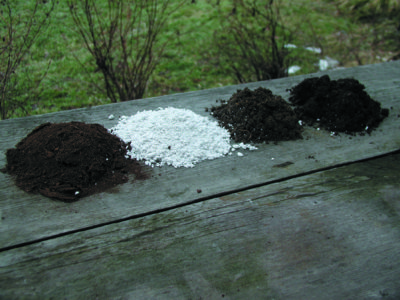
Peat, perlite, soil, and compost

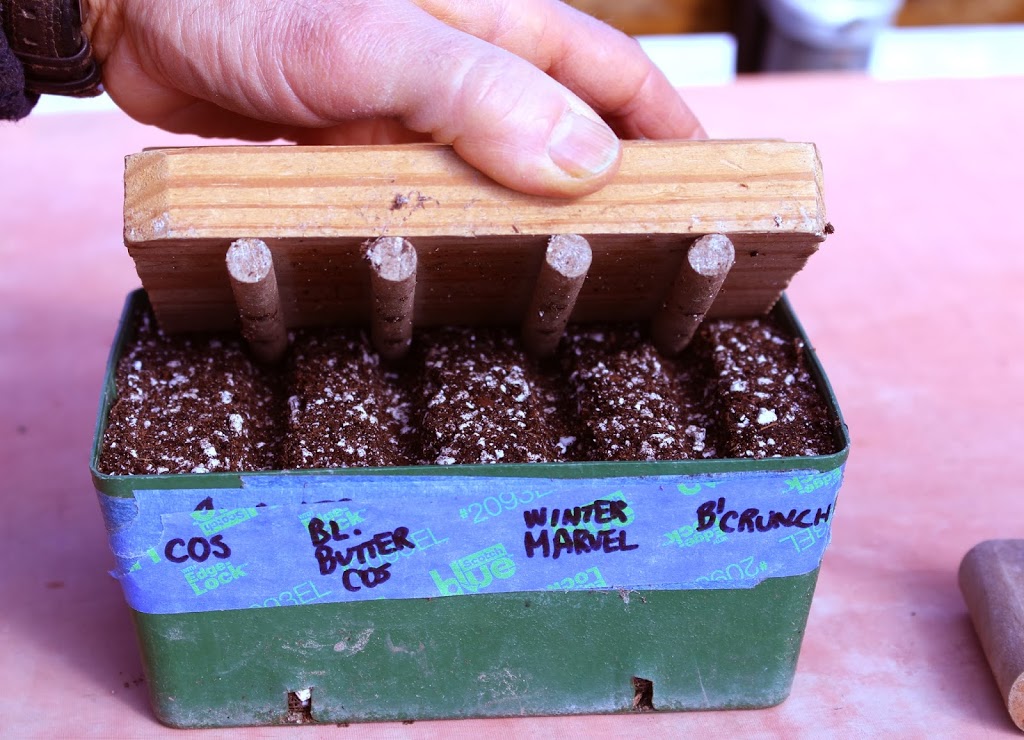
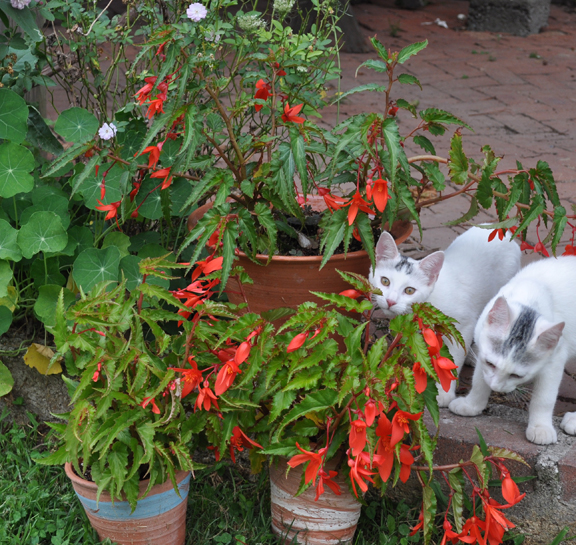
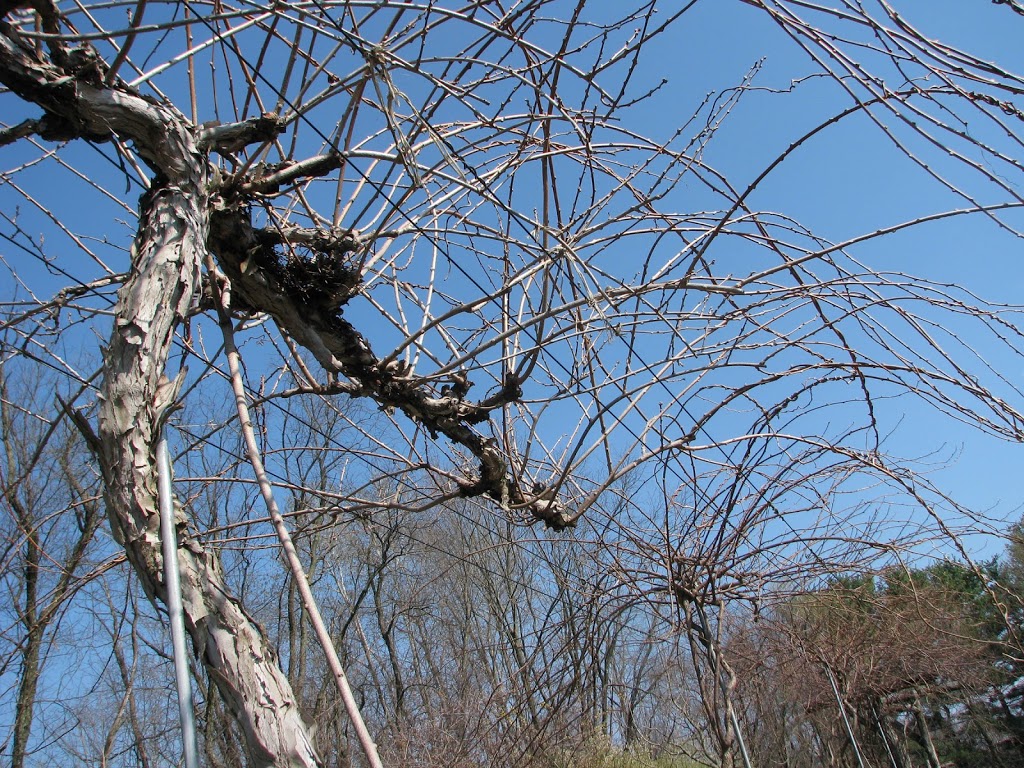
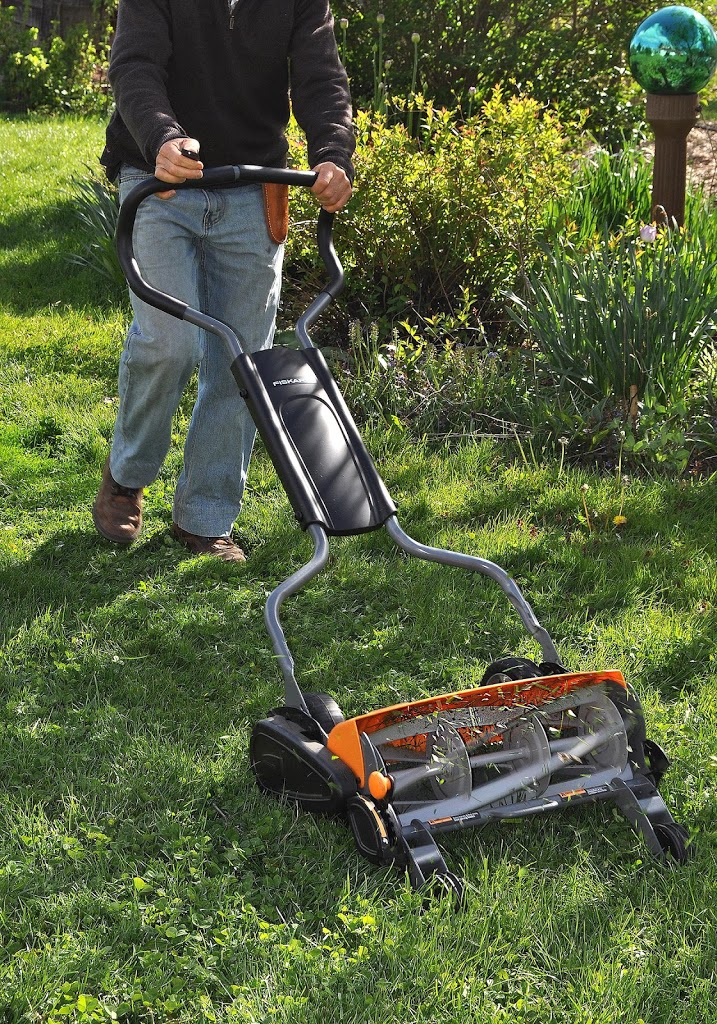

The picture accompanying this piece shows your persimmons, hopefully a few notes about them is on its way,
and Asian pears?
Yes, I too have Asian pears, espaliered, 4 years old. I am hoping this will be their first fruiting year. How do I prune in February (zone 7A), to encourage fruiting next year. Thanks, Lee.
Hard to say because it depends on the training system, the rootstock, and the kinds of growth you’re looking at. Generally, I cut verticals down to stubs 1/4″ or so. But there’s more.
So much for leaving the plants outside till December!!! We’ve had a crazy bout of weather in the teens- with snow!
So interesting about the potting soil, Lee. I had always used straight bagged potting soil but this might be why I have difficulties. I brought in some beautiful geraniums and Matchbox peppers that were too lovely to leave out to freeze. I potted them in plastic pots (easier to carry!) and bagged potting soil. I have a great grow light stand that holds 4 full flats. I did also notice a horde of tiny “flies” that decided to cover my peppers, leaving a fine grayish dust on the floor and on the leaves. What to do?
Also, do you make your soil mix and store it in a can for easy use, or do you prefer to mix it up as you go? Where do you buy your components?
Diane in the Adirondacks
Those “flies” are fungus gnats” which often come from excessive watering. There is also a strain of BT biological insecticide that kills them. I get components for my mix usually from a local garden center, Agway around here..
One of your potting soil ingredients is…potting soil. Is that just any commercial potting soil? If so, have you found a good peat-free mix? Thanks!
It was supposed to read “garden soil” as the first ingredient. Now corrected on blog.
I may have to grow a fig in my new winter home! They are so beautiful and delicious. I used to lug so many pots down to our northern cellar every fall and up again in the spring and for me, too, those days are over. I am so happy for your new found Ritz! I am also on the search for a cyclamen. I don’t think the regular grocery store variety is hardy to zone 9. We can have temperatures in the mid 20s but just for a day or two. But the hardy cyclamen may work here, too. Thank you!
Could you elaborate a bit on the difference between the potting soil mix you are creating and the potting soil ingredient in said mix? My previous understanding was that potting soils were usually soil-less mixes of compost, aggregate, and non-nutritive plant material like peat or coir. Is your fourth ingredient in the mix just garden soil?
Also, thanks for the timely post, I was just pondering how to winterize my 1 year old potted fig whip. Should I bother root pruning after this first year, or let it go a second year before its first root pruning?
The first ingredient in the mix should have read “garden soil,” not “potting soil.”
Root prune the plants when they get root bound which, depending on the size of the pot and the amount of growth could be one or two years, or more.
“…equal parts potting soil, perlite, compost, and peat moss.”
Is it garden soil or potting soil that is the first part of that mix?
My mistake. I meant to write “garden soil, perlite, compost, and peat moss.” I’ve since corrected it on the page.
Hi , Jesse here. I’am a fig grower among many other odd fruits. Had about 6 different types mostly winter hardy brands. Tried growing out side in ground (zone 6) like in my last comments, your right the the Hardy types die and grow back, start figs but don’t grow long enough to ripen. So I have been putting them in the garage over the winter. For 4 years been getting away with that. But last year lost all of them.Some were 3 or 4 years old with nice fat trunks. Thought maybe root bound. in 15-20 gallon pots. Nice to know I can trim the roots now. But even the young new coloned ones died also.Temps. do get down there 10 degrees. was I just getting lucky, those prior years. I was stilling getting viable cuttings in mid. winter. the one thing I did do different , come spring had extra dormant oil in sprayer tank. And used it on them. What do you think. Was I just getting lucky the other years from the cold or did I spray them to death.
Thanks for all you do for us with your knowledge and info. emails.
Unless you didn’t follow directions for the dormant oil spray, I’d say it’s the cold that killed them, some combination of the depth and duration of cold. Roots of any plant aren’t as cold-hardy as the tops.
Although dormant oil is relatively benign, it can damage plants. I wouldn’t use it unless it’s called for, which I doubt on your figs. (My greenhouse figs are another story, though.)
Hi.
1) Can root pruning as shown above be done on all container grown fruit trees?
2) what should the minimum size of the container be if the height of the fruit tree we’re to be maintained at say 6ft.
Thanks.
Yes, any tree can be root pruned. I would not have a container smaller than about 18″ in diameter for a tree maintained at 6-feet-tall.
I have a fig whip in a greenhouse (1st season)
after reading the comments I was wondering if there is anything I needed to do over the winter to help the fig, I don’t expect to get lower than 40 degrees
And can you recommend a resource to learn about growing figs in greenhouses?
Thanks
Nothing special needed to overwinter the fig at temperatures above the high 20s. As far as resources, I’m just finishing up a booklet I am writing about growing figs in cold climates.
Excellent, you are the most prominent author in my collection of gardening books. Thanks